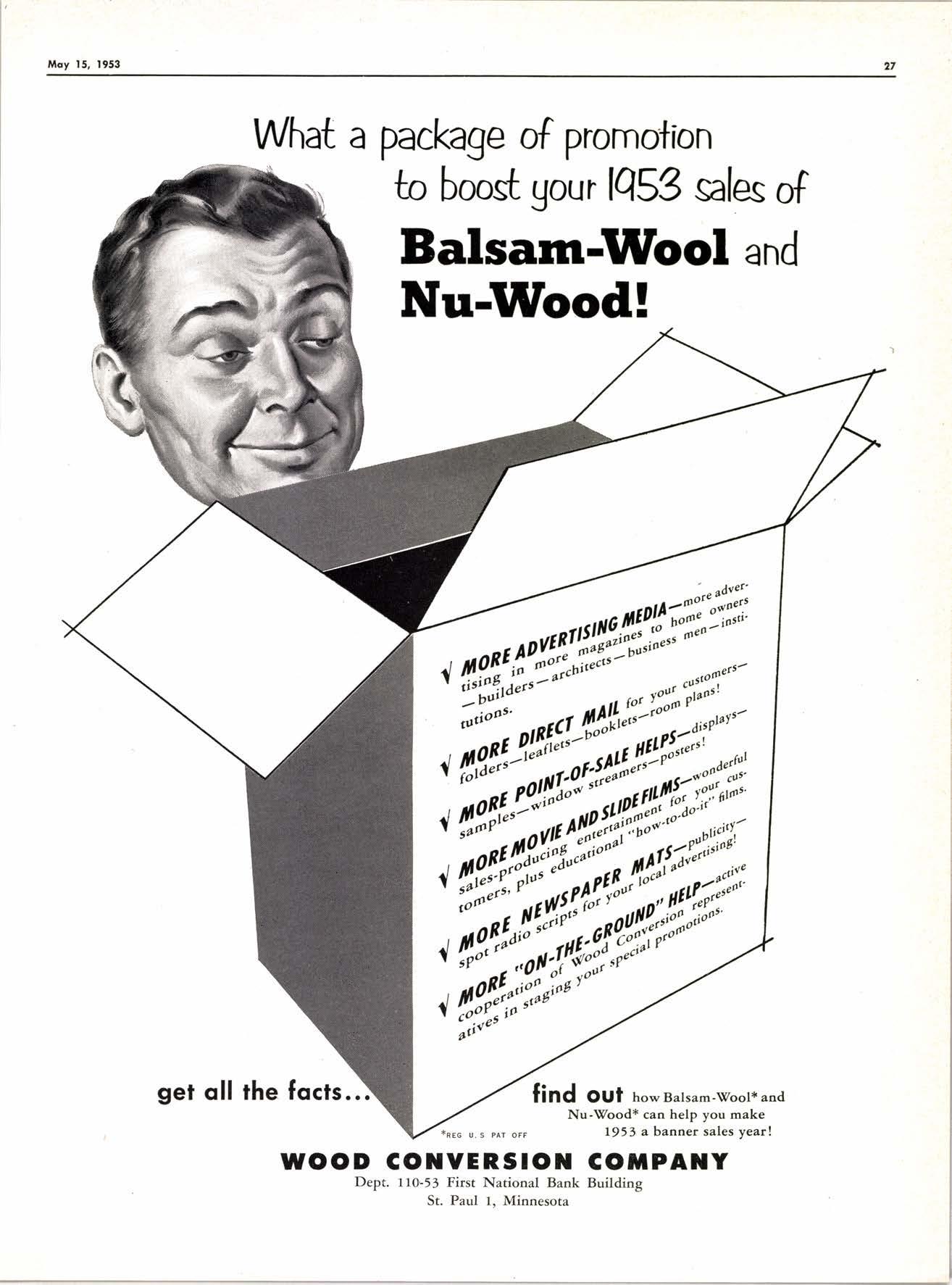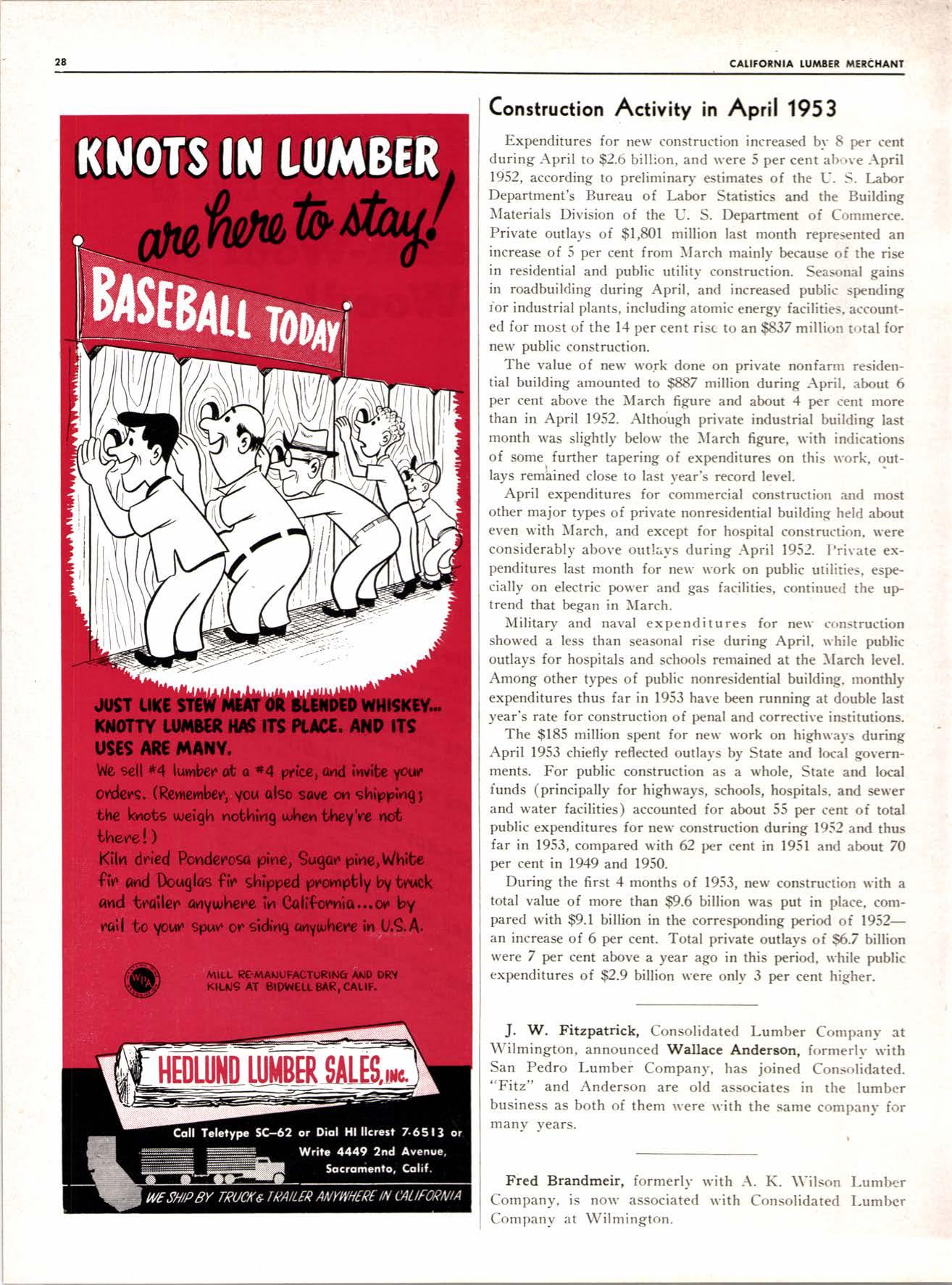
4 minute read
for homes . schools . . . indlrstrial build;i,ngs
stRllGllI GlutD lAilrtATED rttBtRs
Stronger than solid sawn timbers...Lam-Loc Timbers take up to 15/6 more load than solid sawn timbers of the same size.
Approved for use in buildings throughout California, including school buildings and installations in the city of Los Angeles lechnicol lnformqtion: Call Axel V. Pederson, exminster 1-5494, l-1869 Gluoto?lon3: Phone, write
Cheoper than structural steel...Lam-Loc Timbers save up to 70% on instdled cost, compared to steel, in the most common spans of 25 to 50 feet. More Beoutifut than either solid sawn timtrers or steel...Lam-Loc Timbers never warp, twist or crack...are truly beautiful when finished "naturall' revealing the pattern of laminations and tapered scarf-joints.
AND...AVAIIAIIE IHROUCH ANY' lU'f,BER DEATER
National Forest Recreation Use Increases Army To Continue !(ood for Gondolas
Recreation use of the 18 National Forests in California increased l9/o in 1952, over the previous year, according to information reported by Nf. M. Barnum, Regional Chicf of Recreation and Lands for the Forest Service. The report summary for 1952 shorvs 4,730,W0 visits involving 12,726,W man-days use of forest facilities and improvcments. An additional 16 million visits to the Forest are recorded for sightseers passing through.
The 1952 summer recreation season got oft to a slorv start because of cold, stormy rveather in June. Horvever, July turned out to be the largest on record for public campgrounds as well as private resorts in the Forests.
"The ever increasing popularity of the outdoor recreational opportunities provided by the National Forests calls for a greatly intensified Forest Service program of sanitation control, fire prevention, and safe rvater supplies," N[r. Barnum explained. "Most of the present improvements and facilities for public recreation on the National Forests \'vere constructed in the early 1930's and are norv giving way from age and excessive use."
The importance of public cooperation in keeping campgrounds clean and facilities in good condition rvas stressed by the regional recreation chief.
Glen Ainsworth of the Ralph L. Steel took a trip back East on business last up a new car at the factory-.
Lumber Company month and picked
\\rashington, D.C.-The Army's Transportation Corps estimates that it will save $250,000 by using tongue-andgroove rvood sides instead of steel plates for an undisclosed number of 4o-ton high sided gondola freight cars to be ordered soon for o\'erseas use. This information confirms arguments long and vigorously advanced by the National Lumber l\Ianufacturers Association.
Transportation Corps officials said the difference in cost is one of the main reasons they r,r'ill continue to order overseas gondola cars exculsively with u'ood sides.
The Corps recognizes that not only is there a saving in initial costs but repairs also are easier and cheaper because no special material is required.
The Corps rvill not disclose the number of cars involved in the forthcoming order, or the estimated saving on each car, until it has let contracts for their construction.
Present plans call for steel underframes and undercarriages for the cars. The rvood sides rvill be bolted to steel superstructure frames rvhich, in turn, s'ill be attached to the underframes of the cars.
Los Angeles Building Permits
5,375 building permits rvere issued in the city of Los Angeles during the month of April rvith a valuation of $32,5%,4D. In the preceding month. lfarch, 6,413 permits rvere issued valued at ffi6,596,944.

Construction Activity in April 1953
Expenditures for new construction increased br-8 per cent during -\pril to $2.6 billron. and s'ere 5 per cent ab,'r-e -\pril 1952, according to preliminary estimates of the U. S. l-abor Department's Bureau of I-abor Statistics and the Building Ilaterials Division of the U. S. Department of Cornrnerce. Private outlays of $1,801 million last month represented an increase of 5 per cent from llarch mainly because of the rise in residential and public utilitl' construction. Seasonal gains in roadbuilding during April, and increased public spending ior industrial plants, including atomic energy facilities, accounted for nlost of the l-{ per cent risc to an $837 million t,rtal for new public construction.
The value of new u'ork done on private nonfarrn residential building amounted to 9887 million during April. about 6 per cent above the }Iarch figure and about 4 p€r cent ntore than in April 1952. Although private industrial building last month was slightly below the llarch figure, rvith indications of some, further tapering of expenditures on this srrrk, outlays remhined close to last year's record level.
April expenditures for commercial construction and rnost other major types of private nonresidential building held about even with March, and except for hospital construction. \r.ere considerably above out!;,vs during April 195?. I'rir-ate expenditures last month for neu' u'ork on public utilities, especially on electric po\{'er and gas facilities, continue(l the up trend that began in }Iarch.
Nlilitary and naval expenditures for neu- cr,nstruction showed a less than seasonal rise during April. s'hile public outlays for hospitals and schools remained at the \farch level. Among other types of public nonresidential building. rnonthly expenditures thus far in 1953 have been running at double last year's rate for construction of penal and corrective institutions.
The $185 million spent for neu' *'ork on highs'avs during April 1953 chiefly reflected outlavs by State and local sovernments. For public construction as a whole, State and local funds (principally for highways, schools, hospitals. and sewer and rn'ater facilities) accounted for about 55 per cent of total public expenditures for neu. construction during 1952 and thus far in 1953, compared w'ith 62 per cent in l95l and about 70 per cent in 1949 and 1950.

During the first 4 months of 1953, new construction rrith a total value of more than $9.6 billion was put in place, compared with $9.1 billion in the corresponding period oi 1952_ an increase of 6 per cent. Total private outla.vs of 96.7 billion u'ere 7 per cent above a year ago in this period, rvhile public expenditures of $2.9 billion rrere onlv 3 per cent higher.
J. W. Fitzpatrick, Consolidated Lumber Conrpanv at Wilmington, announced Wallace Anderson, formerlv rvith San Pedro Lumber Company, has joined Consolidated. "Fitz" and Anderson are old associates in the lumbcr business as both of them l'ere u-ith the same comyrarr-v for manv vears










